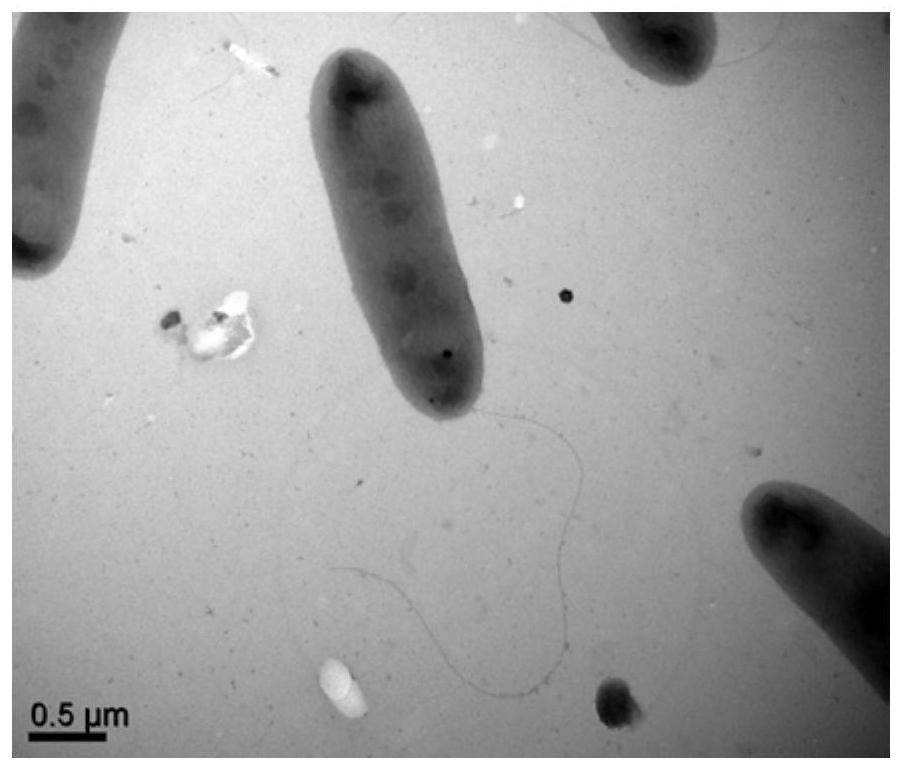Pseudomonas luteolus wxp-4 and its application in denitrification
A WXP-4, Pseudomonas technology, applied in the direction of bacteria, microbial-based methods, biological water/sewage treatment, etc., can solve the problems of low nitrification rate, time-consuming, cost-intensive, etc.
- Summary
- Abstract
- Description
- Claims
- Application Information
AI Technical Summary
Problems solved by technology
Method used
Image
Examples
Embodiment 1
[0032] Example 1: Isolation, purification and identification of Pseudomonas citronellolis WXP-4
[0033] 1. Isolation and purification of Pseudomonas citronellolis WXP-4
[0034] Pseudomonas citronellolis WXP-4 is sieved from the aerobic sludge tank of Qige sewage treatment plant. The specific steps are as follows:
[0035] The enrichment medium preparation method is as follows: Sodium succinate 2840mg L -1 , NaNO 2 345mg·L -1 , (NH 4 ) 2 SO 4 270mg·L -1 , KH 2 PO 4 1360mg·L -1 , MgSO 4 ·7H 2 O 190mg·L -1 , yeast extract 1000 mg·L -1 , trace elements 1ml·L -1 , pH=7.0, agar 20g·L -1 , the solvent is deionized water, pH=7.0.
[0036] DM Liquid Selection Medium: NaNO 3 610mg·L -1 , sodium succinate 2360mg·L -1 , KH 2 PO 4 1500 mg·L -1 , MgSO 4 ·7H 2 O 100mg·L -1 , Na 2 HPO 4 12H 2 O 7715mg·L -1 , trace elements 2ml·L -1 , agar 20g·L -1 , the solvent is deionized water, pH=7.0.
[0037] The final concentration of trace elements is composed of: ED...
Embodiment 2
[0046] Embodiment 2 Pseudomonas lanceolol WXP-4 seed culture solution
[0047] (1) Slant culture: Inoculate Pseudomonas luteolus WXP-4 into BTB medium (same composition as in Example 1), and culture at 30°C for 1 day to obtain slant cells;
[0048] (2) Seed culture: Pick colonies from the slant and inoculate them into LB medium, culture at 30°C for 12 hours, and obtain OD 600 It is 1.5 seed solution, which is the bacterial suspension; the final concentration of the LB medium is composed of: NaCl 10g / L, peptone 5g / L, beef extract 10g / L, solvent is deionized water, pH value 7.0.
Embodiment 3
[0049] Example 3: Detection of denitrification performance of Pseudomonas luteolus WXP-4
[0050] 1. Investigate the reduction of NO by Pseudomonas luteolin WXP-4 under different carbon sources 3 - -N performance
[0051] Implementation of NO reduction by Pseudomonas luteolus WXP-4 under different carbon sources 3 - -N experiment, the results show that its best carbon source is sodium succinate, and the specific implementation is as follows:
[0052] OD prepared by embodiment 2 method 600 The bacterium suspension of 1.5 was inoculated to 5 kinds of DM liquid selective media of different carbon sources according to volume concentration 1% inoculum (all with NO 3 - -N is the only nitrogen source), 30°C, 160rpm shaking culture for 10h, take 1mL of each culture solution and centrifuge at 10000rpm for 5min to remove microorganisms to obtain the supernatant, and then use a UV spectrophotometer to measure its concentration at 220nm and 275nm respectively Absorbance value, A=A ...
PUM
 Login to View More
Login to View More Abstract
Description
Claims
Application Information
 Login to View More
Login to View More - R&D
- Intellectual Property
- Life Sciences
- Materials
- Tech Scout
- Unparalleled Data Quality
- Higher Quality Content
- 60% Fewer Hallucinations
Browse by: Latest US Patents, China's latest patents, Technical Efficacy Thesaurus, Application Domain, Technology Topic, Popular Technical Reports.
© 2025 PatSnap. All rights reserved.Legal|Privacy policy|Modern Slavery Act Transparency Statement|Sitemap|About US| Contact US: help@patsnap.com



